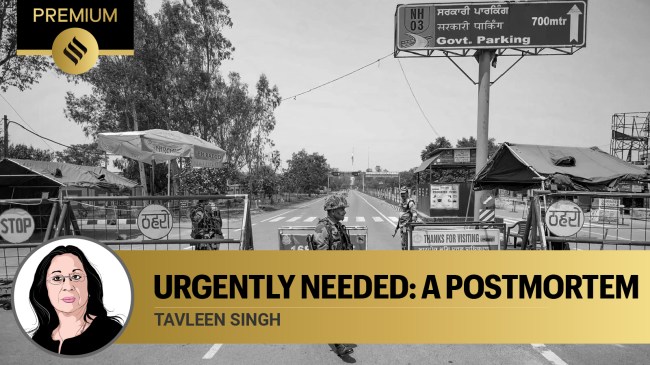Opinion Tavleen Singh writes | Urgently needed: A postmortem
If there had been real reportage, we would at least know, now that the fog of war has lifted, whether Pakistan’s military machine is as good as ours and if it is, we should know why.
 The purpose of Operation Sindoor was to send Pakistan’s military rulers the message that their jihadi foot soldiers would no longer be able to wander about India, killing unarmed civilians. (PTI Photo)
The purpose of Operation Sindoor was to send Pakistan’s military rulers the message that their jihadi foot soldiers would no longer be able to wander about India, killing unarmed civilians. (PTI Photo) The defining image of Operation Sindoor for me is that photograph of senior Pakistani military officers at the funeral of a dead jihadi. In the photograph, they stand behind a bearded jihadi who stands beside the coffin of his dead relative. The coffin is covered in the Pakistani flag and wreaths of red roses lie on it. The photograph has been viral on social media for days and the names of the senior Pakistani officers mourning the death of the Lashkar-e-Taiba terrorist have been made public by our government.
This photograph, which I have looked at many times, left me stunned because of the utter shamelessness it depicts. Ever since the horrendous massacre in Pahalgam, there has been a collaborative campaign by Pakistan’s military and civilian rulers to convince the world that the old policy of using jihadi terrorism as a weapon of war has ended. When the Islamist Republic’s military rulers are unable to convince the world of their credentials, they usually summon English-speaking, attractive civilians from well-known political families to make the case for them.
This time it was Bilawal Bhutto and Hina Khar (she of the Birkin bag fame) who were tasked with denying that Pakistan has anything to do any more with jihadi terrorism. Bhutto admitted that official support for jihadist terrorism was something that happened once but in ancient history. And Madame Khar made similar claims on a British TV show, while delicately fiddling with her perfectly groomed hair and lacy white dupatta. Until Barkha Dutt asked her to state clearly if she believed groups like the Lashkar-e-Taiba and Jaish-e-Mohammed were terrorist outfits. Instead of answering the question, she fled and where her face had been, there was a blank window for the rest of the show.
If there is one thing that Pakistan has revealed, albeit unintentionally, is that it continues to nurture evil, cowardly fanatics who lack the courage to fight real wars and choose instead to kill innocent people. This alone means that India won the war. The purpose of Operation Sindoor was to send Pakistan’s military rulers the message that their jihadi foot soldiers would no longer be able to wander about India, killing unarmed civilians. This message was convincingly delivered with attacks on the headquarters of Lashkar-e-Taiba in Muridke and Jaish-e-Mohammed in Bahawalpur. And similar messages were delivered to jihadist encampments in Pakistan-occupied Kashmir.
Where India lost, as it often does, was in countering Pakistan’s narrative with a more convincing narrative of our own. So, it has been asked far too many times not just by Pakistanis, but by Western commentators, why India had not provided proof that the massacre in Pahalgam was ordered by Pakistan. This emboldened far too many Pakistanis to repeat, ad nauseum, that what happened in Pahalgam was a “false flag operation”. When you live in a country that has been ruled by military men for most of its existence, it is easy to believe that it’s possible for an Indian Prime Minister to kill his own people just to find a reason to go to war. It cannot happen in a democratic country. Period.
Proof of this is that every time the Indian state has been involved in a pogrom or causing communal violence, it has been exposed and vilified. The list is too long to repeat here, but three come immediately to mind. Hashimpura in 1987, Delhi in 1984 and Gujarat in 2002. Justice may not have been fully done, but the state has been identified as the perpetrator of violence in all three cases.
In a wider sense, India’s messaging has been so faulty that commentators on the other side of the border believe that Hindutva is just a Hindu version of radical Islam. As someone who has not the slightest sympathy with the Hindutva ideology or its adherents, I am a little embarrassed to have to say that the equivocation is not just false, but ludicrous. The vigilantes who wander about killing Muslims on the excuse of saving cows do not have religious sanction. That is a vital difference.
The question we should be asking is why India seems so often to lose control of the narrative? One big reason is that our private TV channels have been so jingoistic and hysterical in their coverage of Operation Sindoor that they have harmed not just their own credibility, but the government’s credibility as well. With a handful of exceptions, most TV reporters and anchors spent more time whipping up rabid nationalism than reporting the news. It has astounded me to see how many anchors chose to express their personal opinions on Pakistan instead of trying to report fairly on what was happening.
If there had been real reportage, we would at least know, now that the fog of war has lifted, whether Pakistan’s military machine is as good as ours and if it is, we should know why. These are the sort of questions that would be asked if the Indian media had not been, for one reason or another, cowed into submission. Lieutenant-General H S Panag, whose views I respect, said in a recent article that technologically, Pakistan is at near parity with India and that there is need for urgent transformation in the Armed forces. In his words, “It’s crucial that the defense Budget is doubled to 4% of the GDP”. That is a truly sobering statistic.



